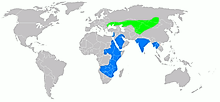The Steppe Eagle (Aquila nipalensis) is one of the most striking visitors to Manas National Park during the winter months. The International Union for Conservation of Nature (IUCN) has classified this majestic bird as endangered since 2015. Its large size, brown upper parts, blackish feathers, tail, and pale throat make it an unmistakable sight for bird enthusiasts and conservationists.
Physical Characteristics and Call
A Steppe Eagle can reach a wingspan of 2.2 meters, making it a large bird of prey. The bird's plumage is primarily dark brown, with blackish flight feathers and tail. Pale throats provide a distinctive contrast, making identification easier. Despite its large size, the Steppe Eagle is relatively silent. Even though it is typically a quiet bird, its call resembles that of a crow.
Diet and Hunting Behavior
A Steppe Eagle's primary diet consists of fresh carrion, which it scavenges efficiently. However, it is a skilled hunter, capable of killing rodents, small mammals up to the size of hares, and birds up to the size of partridges. As a result of this adaptability in diet, the Steppe Eagle thrives in a variety of habitats. A unique feature of the Steppe Eagle is its crop, a specialized throat pouch that allows it to store food for several hours before digesting it. When food is scarce, this adaptation allows the eagle to survive on fewer meals.
Conservation Status and Threats
There has been an extremely rapid decline in the Steppe Eagle population, particularly within its European range. Diclofenac is a nonsteroidal anti-inflammatory drug that is toxic to many bird species, including vultures and eagles, which is one of the primary threats to its survival. Diclofenac can poison scavenging birds like the Steppe Eagle when livestock treated with it die. A significant mortality rate has resulted from this issue, contributing to the species' endangered status.
Cultural Significance
The Steppe Eagle is a part of Kazakhstan's cultural heritage, appearing on the national flag. Especially among Kazakh tribes, the eagle has been a symbol of freedom, power, and the desire to soar. The Steppe Eagle is a symbol of the region's cultural and national identity, which is why it's on the flag.
Importance of Conservation Efforts
The Steppe Eagle's survival depends on conservation efforts. It is essential to protect their habitats, regulate harmful substances like diclofenac, and promote awareness about their endangered status. Governments and organizations must work together to implement conservation strategies that address the specific threats faced by the Steppe Eagle.
Observing Steppe Eagles at Manas National Park
Bird watchers and nature enthusiasts will enjoy observing the Steppe Eagle in its natural habitat. This magnificent bird can be seen during the winter months in Manas National Park due to its diverse ecosystem. Observers can observe eagles perched on high vantage points, scanning the landscape for prey or scavenging opportunities.
Conclusion
It is a remarkable bird of prey that captivates those who have the chance to observe it. Manas National Park's presence of this species illustrates the importance of preserving natural habitats and implementing effective conservation measures. Taking proactive steps to protect the Steppe Eagle will ensure that future generations will continue to marvel at this majestic bird by understanding the challenges it faces.
The Steppe Eagle's survival depends not only on conservation efforts, but also on maintaining the ecological balance in its habitats. In order to preserve biodiversity on our planet, we must protect species like the Steppe Eagle.




Comments
Post a Comment